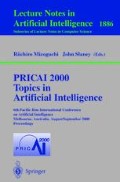Abstract
An epistemic state here means a total preorder on the set of possible worlds. Simple epistemic states, with one or two equivalence classes, correspond to belief sets. Relative to a fixed belief set t, we define a comparative order on belief sets, expressing that ‘y sorts the worlds closer to the way in which t sorts them than x does’. This induces a Boolean algebra, ordered very differently from, but isomorphic to the Lindenbaum-Tarski algebra under the isomorphism which sends x to x↔ t. The isomorphism allows us to classify each inferential or conjectural step as being either in concord or in discord with the beliefs t. So t may now guide the logical dynamics of inference and conjecture, and hence of corroboration, refutation, diagnosis, abduction, etc. Going from belief sets to more general epistemic states, we show how similar constructions may guide AGM belief change.
Access this chapter
Tax calculation will be finalised at checkout
Purchases are for personal use only
Preview
Unable to display preview. Download preview PDF.
References
Alchourrón, C, Gärdenfors, P., Makinson, D. (1985) “On the logic of theory change: Partial meet contraction and revision functions”, Journal of Symbolic Logic 50, 510–530.
Bar-Hillel, Y., Carnap, R. (1953) “Semantic information”, The British Journal for the Philosophy of Science 4, 147–157.
Brink, C. (1989) “Verisimilitude: Views and reviews”, History and Philosophy of Logic 10, 181–201.
Dubois, D., Lang, J., Prade, H. (1991) “A possibilistic assumption-based truth maintenance system with uncertainty justifications, and its application to belief revision” pp. 87–106 in Martins, J.P., Reinfrank, M. (eds.) (1991) Truth maintenance systems (LNAI, Vol. 515), Springer-Verlag, Berlin.
Forbus, K.D., de Kleer, J. (1993) Building Problem Solvers, MIT Press, Cambridge MA.
Kuipers, T.A.F. (1987) “A structural approach to truthlikeness”, pp. 79–99 in Kuipers, T.A.F. (ed.) (1987) What is Closer-to-the-truth? (Poznan Studies in the Philosophy of Science, Vol.10), Editions Rodopi, Amsterdam.
Kuipers, T.A.F. (1992) “Naive and refined truth approximation”, Synthese 93, 299–341.
Laux, A., Wansing, H. (eds.) (1995) Knowledge and Belief in Philosophy and Artificial Intelligence (Series Logica Nova), Akademie Verlag, Berlin.
Miller, D. (1978) “On distance from the truth as a true distance”, pp. 415–435 in Hintikka, J., Niiniluoto, I., Saarinen, E. (eds.) (1978) Essays in Mathematical and Philosophical Logic, D.Reidel, Dordrecht.
Nayak, A., Foo, N. (1998) “Reasoning without minimality”, pp. 122–133 in Lee, H., Motoda, H. (eds.) (1998) PRICAI’98: Topics in Artificial Intelligence. Proceedings of the Fifth Pacific Rim International Conference on Artificial Intelligence (LNAI, Vol. 1531), Springer-Verlag, Berlin.
Nayak, A., Foo, N. (1999) “Abduction without minimality”, pp. 365–377 in Foo, N. (ed.) (1999) Advanced Topics in Artificial Intelligence. Proceedings of the 12th Australian Joint Conference on Artificial Intelligence (AI’99) (LNAI, Vol. 1747), Springer-Verlag, Berlin.
Niiniluoto, I. (1998) “Verisimilitude: The third period”, The British Journal for the Philosophy of Science 49, 1–29.
Zwart, S.D. (1998) Approach to the Truth: Verisimilitude and Truthlikeness (ILLC Dissertation Series 1998-02), Institute for Logic, Language and Computation, Amsterdam.
Author information
Authors and Affiliations
Editor information
Editors and Affiliations
Rights and permissions
Copyright information
© 2000 Springer-Verlag Berlin Heidelberg
About this paper
Cite this paper
Heidema, J., Burger, I.C. (2000). Epistemic States Guiding the Rational Dynamics of Information. In: Mizoguchi, R., Slaney, J. (eds) PRICAI 2000 Topics in Artificial Intelligence. PRICAI 2000. Lecture Notes in Computer Science(), vol 1886. Springer, Berlin, Heidelberg. https://doi.org/10.1007/3-540-44533-1_30
Download citation
DOI: https://doi.org/10.1007/3-540-44533-1_30
Publisher Name: Springer, Berlin, Heidelberg
Print ISBN: 978-3-540-67925-7
Online ISBN: 978-3-540-44533-3
eBook Packages: Springer Book Archive

